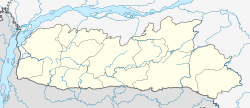Cathedral of Mary Help of Christians
| Cathedral of Mary Help of Christians | |
|---|---|

Cathedral of Mary Help of Christians
|
|
| 25°34′06″N 91°53′29″E / 25.568448°N 91.891343°ECoordinates: 25°34′06″N 91°53′29″E / 25.568448°N 91.891343°E | |
| Location | Laitumkhrah, Shillong |
| Country | India |
| Denomination | Roman Catholic |
| History | |
| Founded | 1936 |
| Architecture | |
| Status | Cathedral |
| Functional status | active |
| Administration | |
| Archdiocese | Archdiocese of Shillong |
| Clergy | |
| Archbishop | Dominic Jala, SDB |
The Cathedral of Mary Help of Christians is a Cathedral in Shillong, Meghalaya. It is the cathedral of the Roman Catholic Archdiocese of Shillong which covers the [East[Khasi Hills and RI Bhoi district of Meghalaya. The Cathedral is the principal place of worship of the over 300,000 strong Catholics of the Shillong Archdiocese which covers RI Bhoi and East Khasi Hills district of Meghalaya. An Archdiocese is a “diocese" or area under the jurisdiction of an Archbishop. In all there are 33 church districts or “Parishes” in the Shillong Archdiocese. The Cathedral Church was built over 50 years ago. Since it also has the “cathedra” – the seat or throne of the Bishop – it is known as a Cathedral Church. This place of worship stands on the very site of the first Church built by the German fathers. The earlier 1913 building – the Church of the Divine Saviour – was a wooden structure. It was destroyed by the Good Friday fire of April 10, 1936. Built by the first Catholic missionaries to these hills, the Salvatorian Fathers from Germany, it was the first Catholic Cathedral Church in what was then the Mission of Assam.
Built by the first Catholic missionaries to these hills, the Salvatorians from Germany (of the Society of the Divine Saviour), it was the first Catholic Cathedral Church in what was then the Mission of Assam. Construction of the new church of Mary Help of Christians began on the same site on 25 October 1936. The Cathedral Church was buplace of worship stands on the very site of the first Church built by the German fathers (Salvatorians from Germany). The earlier 1913 building – the Church of the Divine Saviour – was a wooden structure. It was destroyed in the Good Friday fire of April 10, 1963. Described as modern Gothic, the Church building plan was approved on August 22, 1936 by the then Chairman of the Shillong Municipality, who was also the Deputy Commissioner of former United Khasi & Jaintia Hills District, Mr. Keith Cantlie. The first stone of the new Church was blessed on October 25, 1936 the feast of Christ the King. A unique feature of the Cathedral Church building is that is stands on sand. The type of foundation was recommended since the region, where Shillong is located, is prone to severe earthquakes. The elasticity is provided by the sand on which the structure has been made to stand. At the time of building the foundation, trenches were cut from rock and half filled with sand. The structure has no direct connection with the rock. Theoretically the Church building, in times of earthquakes, can rock safely on the shock absorbing sand which is supposed to reduce the violence. In 1980, the centenary year of the Catholic Church in North East India, the then Archbishop, the late Rt. Rev. Hubert D’Rosario, declared the Cathedral Church a shrine, duly approved to be a pilgrimage centre. Since then special church services are held here every Wednesday the year round.
...
Wikipedia

